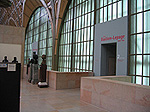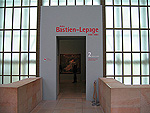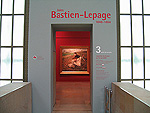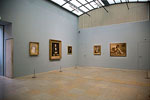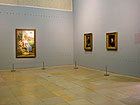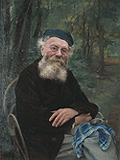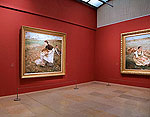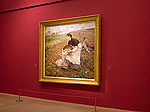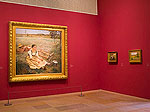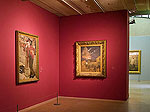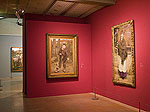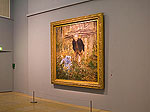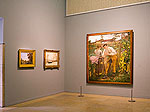The browser will either open the file, download it, or display a dialog.
|
Jules Bastien-Lepage (1848-1884) Jules Bastien-Lepage (1848-1884) |
|||||
| One of the most challenging focused exhibitions of recent years was the retrospective of the works of Jules Bastien-Lepage. This exhibition examined this artist's short career suggesting, especially in the accompanying catalogue, why his paintings had an astounding impact and influence on other artists in the nineteenth century. Developed along chronological lines, the exhibition traced his earliest academic paintings, in a style suggestive of his teacher, Cabanel and other academic painters of the Second Empire, and then moving on to his large-scale Salon paintings expressing a deeply felt nationalistic interest in northern France, specifically the area near Verdun and the small native village of the painter—Damvillers. While Bastien-Lepage has been the subject of a previous exhibition only once before, aside from the large-scale retrospective held after his death in Paris, in 1885, this show should do much, especially with its excellent catalogue written by Dominique Lobstein of the Musée d'Orsay and others, to continue revitalizing his career and reputation. | ||||||
| The first retrospective exposition of Bastien-Lepage's work was held at the Hôtel de Chimay at the École des Beaux-Arts in Paris in 1885, shortly after Bastien-Lepage's death at age thirty-six stunned the art world in 1884. Following this, there was no other major exhibition until the centennial of his death.1 At that time, an exhibition was held in Bastien-Lepage's native region of France, at the Musée de la Princerie in Verdun and at the Musée Citadelle in Montmédy; a catalogue raisonné, prepared by the independent scholar Marie-Madeleine Aubrun, followed shortly thereafter.2 The current exhibition at the Musée d'Orsay is only the second exhibition dedicated to Bastien-Lepage since his death in 1884. Since the previous show covered much the same territory, and was only seen in France, it is regrettable that the current exhibition did not have a venue in the United States where Bastien-Lepage is best represented by his most famous painting, Joan of Arc Listening to Voices, in the collection of the Metropolitan Museum of Art, New York. It is also regrettable that this particular painting, one of the majestic icons of the nineteenth century, was not able to come to Paris. | ||||||
|
The Musée d'Orsay exhibit, though only about half the size of the 1984 centennial retrospective, provided an excellent overview of Bastien-Lepage's talent and diversity. His most important early academic works, and nearly all his major Salon pictures (except for the Joan of Arc) as well as several landscapes and paintings of London vagabonds, were included. The roughly sixty-five works, dated between 1870 and 1884, were organized chronologically and hung somewhat sparsely in five small rooms on the mezzanine section of the museum; one could enter through five separate doors opening onto the sculpture mezzanine, allowing the viewer to see each section independently, or move from one gallery to the next. Each entrance was labeled, with the first and last rooms indicated as such, and each highlighted a single painting seen through an open doorway (figs. 1, 2, 3). One to three pictures hung at eye level on each wall, which allowed for an exceptionally close study of the canvases (fig. 4). While vast exhibits can be overwhelming, small exhibits such as this one afford time to thoughtfully examine the works on display. It seemed, though, that the small number of works was perhaps due to a lack of the availability of some loans. The exhibition space was limited, but there was certainly ample room to include more paintings if necessary. The walls of the first gallery in particular seemed rather sparse with large open areas of blank wall space. At the same time, given the scale of some of the paintings, it was useful to have space around them to give viewer the opportunity to appreciate the entire canvas without having to struggle with other distracting compositions nearby. | |||||
| Very little is known about Bastien-Lepage's work prior to 1870, and thus his earliest works could not be included. In 1868, he entered Alexandre Cabanel's studio at the École des Beaux-Arts where success came quickly after he won a medal in the Salon of 1874, and continued until his untimely death a decade later. His Salon entries for 1874 were Song of Spring and Portrait of the Artist's Grandfather. Both pictures were in the first gallery, which was dedicated to his early works, and were hung on separate walls. Song of Spring, an allegory with three putti and a young bare-footed peasant woman in a landscape setting, won the artist a third-class medal; it was also was purchased by the state (fig. 5). The generic, idealized youthful peasant in Song of Spring formed a stark contrast to the individualized, carefully rendered wrinkled face of the elderly man in Portrait of the Artist's Grandfather (fig. 6). The sensitive treatment of his grandfather in this critically successful portrait would be seen in the figures of his later large-scale naturalist works suggesting that from the very beginning of his career Bastien-Lepage was most comfortable with expanding the canon of observable reality. | ||||||
| In spite of his success with these two pictures, Bastien-Lepage did not win the Prix de Rome competition, and he never achieved the career-making award in the following years. In his mind this was an unfortunate development since winning the Prix de Rome would have assured him academic success. His two unsuccessful attempts for the Prix de Rome included The Annunciation to the Shepherds for the 1875 competition and Priam at the Feet of Achilles for the 1876 competition. These works reflected the artist's struggle to formulate, or even reconcile, his emerging naturalist style evident in his portraits with acceptable Salon themes. Each picture depicts an elderly man, a shepherd in one, and a king in the other, rendered in a far more individualistic way than their youthful counterparts, an angel in the Annunciation to the Shepherds and Achilles in Priam at the Feet of Achilles. The artist's attempts to paint idealized representations of youthful figures, the staples of the École tradition, remained somewhat awkward and unconvincing. He seemed unable to successfully impose classical anatomy and facial features on an imperfect model; he was far more at ease when painting the elderly men in the Prix pictures. It is tempting to think that he had the successful picture of his grandfather in mind when working out his these two compositions. | ||||||
| In the second room of the exhibition were pictures ranging from 1873 to 1881. There were three large paintings of academic subjects, Diogenes, Job, and an unfinished picture of the youthful Ophelia (whose garment matched the pale blue-gray color of the walls). The most striking picture in this room, however, was a portrait of the artist's godchild, called The Communicant, dated 1875. Its stark frontality and the disinterested expression on the young girl's face arrested attention. There was an equally engaging preparatory drawing for the painting, but, unfortunately, it was located in a dimly lit narrow corridor (out of necessity) between the first and second rooms along with twelve other drawings. The fine, delicate modeling of the face in the drawing was reminiscent of portrait drawings by Clouet, Holbein, and Ingres as well as by Bastien-Lepage's teacher, Cabanel. The painting, through pose and implication, revealed Bastien-Lepage's ability to absorb earlier painting traditions—especially from the north—while also creating a work that was inherently original and detailed. In addition, this room included portraits of sitters other than family members. On the same wall as The Communicant hung the Portrait of Simon Hayem (1875). This picture served as an example of Bastien-Lepage's successful career as a portraitist, particularly with bourgeois and Jewish businessmen. Noticeably absent was the portrait of one of Bastien-Lepage's supporters, the art critic Albert Wolff, exhibited in the Salon of 1881—a painting that garnered positive reviews for the artist. This work, available in a private collection in the United States, would have added immeasurably toward demonstrating Bastien-Lepage's ability to capture important sitters while also documenting that Albert Wolff was one of the earliest, major champions of the artist's work and an early collector of the artist's work. This type of contextualization of the artist would also have been extremely valuable earlier in the show. | ||||||
| In moving through the exhibition it was necessary to exit the second room entirely in order to enter the third room, a problem that was somewhat disconcerting as it led to a lack of continued focus. While the walls of the first two exhibition rooms were painted a pale blue-gray, the walls of this room were painted a dramatic eye-popping brick red (fig. 7). With no didactic text to introduce the room, the vibrant color on the walls suggested that this must be the climax of Bastien-Lepage's short career. This should have been the room to stress his importance as the foremost naturalist painter; however, his contribution needed a fuller discussion with wall texts to explain exactly what the artist was achieving, and what the nature of his naturalism actually was. It was clear, though, that he had abandoned academic pictures for his signature large-scale naturalist works depicting peasant field laborers diligently working or at rest. Visible through the entrance was only one large, gorgeous painting, Potato Gatherers, from the Salon of 1879, which also graced the cover of the exhibition catalog (fig. 8). "Damvillers" was written in large letters above the artist's signature, which made clear that Bastien-Lepage proudly painted the people and landscape of his native town. On the right-hand wall was Haymakers, exhibited in the Salon of 1878, which was also painted in Damvillers (fig. 9). Although included in an essay in the exhibition catalog, absent from this room was the Joan of Arc, a pivotal picture exhibited in the Salon of 1880, which would have been an important addition to the other major Salon pictures in this energetic red room. Bastien-Lepage had enjoyed praise for his pictures in the previous two Salons, but received mixed reviews for Joan of Arc, which troubled the artist. As a result, he spent some time in London before returning to Damvillers and focused increasingly on portraiture. Despite his success as a portraitist in London, there were few portraits on view in the last two rooms of the exhibit. It remains confusing why this occurred. Was this due either to difficulty in securing loans, or perhaps in locating some portraits, which often remain with family members? Whatever the reason, there are portraits available that could have thoroughly enlarged the importance and creativity of Bastien-Lepage's later commitment to portraiture. | ||||||
| Showcased through the entrance of the next gallery, this one painted pale blue, was another naturalist picture. Instead of a pretty young peasant woman in the prime of her life, here was an aged, rickety old man positioned in a doorway. The painting was The Beggar from the Salon of 1881, which the artist painted in his studio in Damvillers. Included in this picture is a young girl in the doorway, revealing the artist's interest in the sharp contrast between youth and old age.3 On the other walls were groups of pictures with similar themes, several of Pauvre Fauvrette and portraits of Sarah Bernhardt. The real jewel in this room was the three-quarter length finished profile portrait of Bernhardt holding a statuette of Orpheus modeled by Bastien-Lepage. The masterful monochromatic creamy tones in her elaborate costume and in the backdrop were punctuated by the dark tones of the actress's hair. This picture was exhibited in the Salon of 1879 and won the artist critical acclaim. His ability to depict one of the primary actresses of the period further demonstrated that Bastien-Lepage moved in a culturally chosen company, and that this group of creators sensed a kindred spirit in the young painter. | ||||||
| Just past the portrait of Bernhardt was a corridor leading to the fifth and last gallery. This corridor was painted the same brick red as the third room, but the dimmer lighting lessened the dramatic impact. Four of the five paintings in this corridor were pictures of young vagabonds in London, where Bastien-Lepage had enjoyed great success, and become a magnet for several of the English naturalists, including George Clausen and Henry Herbert La Thangue. The pictures, all dated 1882, included The Young Sleeping Peddler, Pas Mèche (painted for a London dealer), The London Bootblack, and a London Flower Seller, the latter a painting that has only recently been located (figs. 10, 11). Rather than field laborers in landscapes, these are images of poor young workers struggling to survive in urban London. The formats and subjects differed from his Damvillers pictures, and were appropriately given their own space. An exception was a genre scene painted in Damvillers, La Chaîne, which did not fit in with the vagabond theme. Rather, the format was linked to the vertical figures of the other pictures in the corridor. This work would have been better suited to the paintings in the last room where it could have been placed with the other landscapes and pictures painted in Damvillers. | ||||||
| The two major Salon pictures in the fifth and last room were Père Jacques, Salon of 1882, and Village Love, Salon of 1883, both painted in Damvillers. Père Jacques is similar to The Beggar in that both include a little girl with an elderly man. This aged man is bent over from the heavy stack of wood that he hauls on his back, while the sprightly little girl gathers flowers in her hands (fig. 12). Undoubtedly these figures are allegorical in nature: they suggest not only the passage of time but could refer to the seasons with the young girl suggesting Spring and the ancient wood gatherer Fall. In this room, Bastien-Lepage's international appeal and commercial success was explained in the didactic material informing the viewer that Village Love was secured by Parisian art dealer Georges Petit and sold to a Russian collector before it could be purchased by the state (fig. 13). Such success expanded Bastien-Lepage's international reputation and resulted in the coining of the word "Bastienisme" to demonstrate the international scope of his reputation in the 1880s. Elsewhere in the exhibit his popularity with collectors was only slightly referenced. | ||||||
| Several surprising landscapes also hung in the last two rooms. In particular, the brush strokes, subject matter, and viewpoint of London Bridge, dated circa 1881-1882, appeared very Impressionistic. The comparison to Monet's much later Waterloo Bridge was noted in the exhibition catalog although a more likely prototype might have been Monet's 1871 paintings of the port of London, which were purchased by Durand-Ruel in September 1872 (p. 144). Another compelling landscape was Lever de lune à Alger, painted in the last year of Bastien-Lepage's life while the artist was convalescing in Algeria. The broken Impressionistic brush strokes of the foliage and trees in the foreground contrast sharply with the darkening blue sky, which is punctuated only by the small, glowing disk of the moon. These pictures seemed to indicate that the artist was leaning more towards an Impressionistic palette and style in his last years, at least with regard to his forays into landscape painting, an area that was decidedly secondary to Bastien-Lepage. | ||||||
| Works left unfinished at his death hung in the corridor of drawings at the start of the exhibit. Bastien-Lepage's sketches for a planned work for the 1885 Salon, L'Enterrement d'une jeune fille, would have been another naturalist work featuring the people and landscape of his native town. Also among his last works were sketches for a January 1883 commission to design a funeral car for Léon Gambetta, the young head of state whose energy and insight Bastien-Lepage applauded. The unfortunate necessity of hanging the drawings all in one dark corridor between the first and second rooms filled with early works broke the chronological format of the exhibit. It would have been preferable to view these late drawings with his last works. | ||||||
| With little text introducing the rooms or accompanying the artworks, the paintings largely had to speak for themselves. The dearth of explanatory text in the entire exhibit could have been mitigated by placing exhibition catalogs in each of the rooms. For pertinent information on the artist's life, one could consult the well-documented first essay of the exhibition catalog written by Dominique Lobstein. The author divided the life of Bastien-Lepage chronologically and delved more fully into the key years, from the artist's début in 1867 to several longer subsections devoted to important Salon pictures exhibited each year from 1878 to 1880, and then to the final years of the artist's life. The second essay of the catalog, by Emmanuelle Amiot-Saulnier, covers the 1885 retrospective and highlights Bastien-Lepage's influence on George Clausen and the artists Léon Frédéric, Léon Lhermitte, Spaniard José-Julio de Souza-Pinto and Finnish artist Akseli Gallen-Kallela. However, since this exhibit included only works by Bastien-Lepage, it would have been instructive to see works by these artists hanging alongside those of Bastien-Lepage, in order to give the viewer an idea of Bastien-Lepage's full impact on them. Marie Lecasseur's brief essay describes the monument erected in Damvillers for Bastien-Lepage and inaugurated in 1889. That a monument was dedicated to Bastien-Lepage signified the importance attributed to him by his contemporaries, and indicated the same to the modern viewer. For that reason, a welcome addition to the show would have been the maquette of the statue of Bastien-Lepage sculpted by Rodin for the monument in the last room of the exhibit. This maquette exists and would have served as ample evidence to the way in which the leading sculptor of the period valued the works of Bastien-Lepage. | ||||||
| In spite of some regrettable omissions, this exhibit provided a broad range of the artist's creativity, from academic subjects, to naturalist pictures, portraits and landscapes. Since most visitors were introduced to this artist for the first time they had to form their early opinions largely based on the strength of Bastien-Lepage's paintings and drawings on display and, possibly, from the fame of the Joan of Arc canvas. Hopefully most of them after seeing the exhibition also consulted the exhibition catalog, which provided a good overall introduction to the artist's career and to his importance and impact on his contemporaries. However, what would have been most helpful would have been an attempt to situate Bastien-Lepage within his time through the use of explanatory wall labels or photographs of the artist. While it was extremely encouraging to see a formerly marginalized artist receive a retrospective in a major international museum, the show, despite displaying a very commendable sample of his works, was only the beginning of the reappraisal of naturalist painters in museum exhibitions, and of the influence exerted by Bastien-Lepage on the generations who came after him. The significant issues that Bastien-Lepage addressed during his lifetime, including his formulation of a naturalism that enlisted the effects of the environment on figural types as well as the psychological depth of his portraits, are still issues that remain to be forcefully explored by others in the future. At the same time, the exhibition was an eye-opener to many who had no awareness of his work or of his importance for the nineteenth century. | ||||||
| Leanne Zalewski With the assistance of Gabriel P. Weisberg |
||||||
|
I wish to thank Dominique Lobstein, archivist at the Musée d'Orsay, for providing photographs of the exhibition, and Gabriel Weisberg and Janet Whitmore for their helpful comments. 1. Jules Bastien-Lepage: Damvillers 1848, Paris 1884. Exh. cat. (Bar-le-Duc: Conservation départementale des musées de la Meuse, 1984). This exhibition took place at the Musée de la Princerie in Verdun, 5 May through 15 July 1984, and at the Musée citadelle in Montmedy, 21 July through 15 October 1984. 2. Marie-Madeleine Aubrun. Jules Bastien-Lepage, 1848-1884: catalogue raisonné de l'œuvre (Paris: M.M. Aubrun, 1985). 3. Gabriel Weisberg, Beyond Impressionism: The Naturalist Impulse (New York: Harry N. Abrams, 1992), 65. |
||||||


